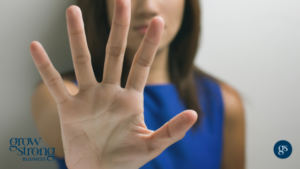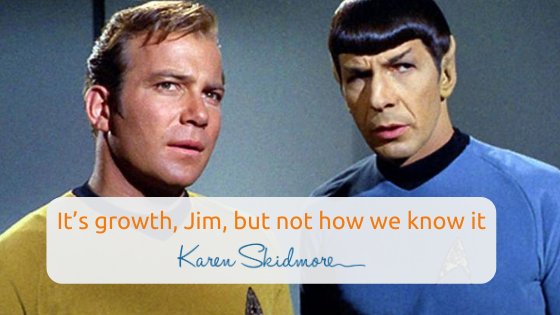
by Karen Skidmore | 08,20 | Business Planning, Pillar Articles, True Profit
One thing you may not know about me is that I am an economics nerd.
I took Economics A Level at school, which was the nearest thing I could study to business due to the limited range of topics on offer.
Even back in 1987, the growth models taught just seemed to be outdated. If countries were going to continue to use GDP (Gross Domestic Product) as a measure of growth, at what point would the charts stop working? You couldn’t just keep going up and up each year, could you?
And this frustrated and bored me, hence my disappointing D grade!
When Freakonomics came out in 2007, I couldn’t put it down. It re-ignited my love for the subject and I came back to exploring and questioning what economic growth meant. But I still couldn’t get my head around the way our economic growth was measured.
Then in 2018, a brand new economics book came out; Doughnut Economic; Seven Ways to Think Like a 21st-Century Economist.
Have you read it?
I’m guessing that unless you are an economic nerd like me, probably not. It’s a great book, but it’s not exactly one of the must-reads of marketing or business books. But for me, OMG … I couldn’t put it down. This was what I had hoped my A-Level course could have focused on when I was 17.
Kate Raworth changed the goal from GDP to Doughnut; identifying how mainstream economics has led us astray by obsessing over growth at all costs, to offering a new model that “brings humanity into a sweet spot that meets the needs of all within the means of the planet’.
OK, great. That all sounds amazing, yes … but what the heck has it got to do with the likes of you and me?
Well, everything IMO.
This backdrop of macro-economics has contributed to our current business culture; work hard to get more.
Do more to get more.
But the good news is that I’ve started to feel the shift.
And I hope you have, too.
These past few months have been a catalyst for so much change … yes, with all changes there is often much discomfort (and sometimes a lot of pain). But the changes feel hopeful; especially in our business culture.
I am witnessing growth in more ways than just money in the bank and numbers of clients in a Facebook Group. Yes, more money is still necessary to many of us. But I’m seeing growth being measured in time spent with family and friends; in our health and fitness; in the impact and difference we can make to people’s lives.
These growth measures are no longer only seen fit for our social enterprises, charities and not-for-profits. They are growth measures fit for our commercial businesses, and the likes of you and me.
And this is what I call True Profit.
True Profit places you, your impact and your wellbeing at the heart of your business, while still recognising the importance of profit and cash flow.
I’d love to know how you are planning to measure your growth over the coming year. Rather than counting pounds in your bank or numbers of clients in a Facebook group, what growth is vital to you?
Until next time, do less, be more and play bigger.

Books Referenced:
Freakonomics: https://www.amazon.co.uk/Freakonomics-Economist-Explores-Hidden-Everything/dp/0141019018
Doughnut Economics: https://www.amazon.co.uk/Doughnut-Economics-Seven-21st-Century-Economist/dp/1847941397
True Profit Business: https://www.amazon.co.uk/True-Profit-Business-without-burning/dp/1788600843/
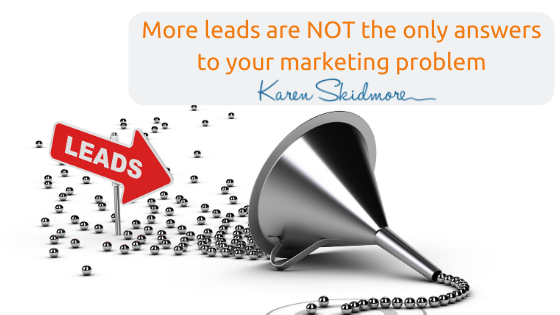
by Karen Skidmore | 11,19 | Marketing Articles, Pillar Articles
To get the leads you feel you need can be exhausting at the best of times; growing and managing free Facebook Groups, posting endless social content and running Facebook ad campaigns (that have the habit of eating up your cash flow!) are all popular ways of generating leads today. Focusing your attention on getting sign-ups to your email list or to get to people into your marketing funnel by offering low-cost digital products can be an important part of your marketing plan.
But did you know there are hidden gems and opportunities in your sales and marketing process that you may simply not be aware of?
What I want to shine the light on here today is you make you consciously aware of the exact steps your clients take with you. Because if you do, it will be far easier for you to spot where the potential opportunities are and do something about them.
And, in the process, you may actually discover that getting more leads, which can be one of the toughest and most expensive problems to solve, may not be the right thing to focus your time and energy on right now.
Let me give you a couple of examples first.
A client I worked with recently was growing her fitness business. She had been teaching Pilates for many years and as her children were growing older, she had the energy and time to step up her business. She had decided she was wanted to create some digital offerings and develop herself as a health coach, which would enable her to move away from having to teach four days a week.
She did exceptionally well in the first six months of her new business, as I helped her create huge numbers of leads through various Facebook challenges and webinars. Once she then decided she was in a position to outsource Facebook ads and hire someone else to run her campaigns, she really flew and was able to take her list from 500 to 4,000 in just three months.
But here was the problem; her sales figures were yet to go much above a few hundred pounds each month and she was struggling to sell enough of her courses to make the shift from teaching classes to online business. Her natural instinct was to go get more leads. But once I helped her shift her attention from lead generation to stages further down her sales and marketing process and work out why people weren’t buying, her business changed for the better.
She adjusted her offers, increased her prices and opened up her diary to allow her to speak to more people, rather than rely on them clicking on a sales page. The shift from only teaching in-person group classes to the online business she desired finally became a reality.
Another client I worked with earlier this year had an amazing Facebook Group, with more than 3,000 members active in it. Running free Facebook Groups is a popular marketing strategy today and, from the outside looking in, it can look like you have a thriving business. But the reality was, for this particular client, that her free Facebook members were sucking her dry of energy and enthusiasm for her business.
She was falling out of love with what she was doing and had essentially trapped herself in the lead generation stage of her marketing, drowning under all the messages, posts and day to day management of the group.
To get back on track with growing her business, I showed how to declutter her offers, streamline her prices and developed a marketing strategy that would essentially take her off Facebook so that she didn’t feel trapped, serving her free audience every day in order to grow her business.
And this is what I want to help you with today. Instead of only thinking that it’s more leads or better quality leads that you need and keep your focus on the lead generation stage, there may actually be easier and simpler solutions further down the line.
Let’s break down the stages and you’ll be able to see where you may need to shift your attention if your lead generation focus is getting you nowhere fast.
The sales and marketing process for businesses like yours can be broken down into five stages.
- Leads
- Prospects
- Conversion
- Value
- Frequency
1) Leads – these are the initial shows of interest.
Leads are not Likes on your Facebook page nor are they retweets of your blog articles (although both can give a good indication on whether you have a potential audience out there).
Leads are people who make them known to you and you have basic information about them. For example, emails subscribed to your list, registrants for your webinar or people in your free online groups. Leads are people who have shown themselves to you as being genuinely interested in what you share but all you know about them at this stage is perhaps their name or simple contact details.
Just think of leads as the initial handshake when you meet someone for the first time.
2) Prospects – these are people who have taken a step further into the enquiry process with you.
Prospects have either requested a call with you, clicked several links in your emails to your various offers, filled in an enquiry form, requested a brochure from your website or even spent money with you, but at a low price point. It’s really important that you decide on your own definition of who a prospect is for your business because every business will be slightly different here, but it doesn’t need to be complicated.
Just imagine yourself with a room full of people, who maybe have heard you speak or explain your business and they’ve put their hands (maybe only tentatively to start with), wanting to know more about what it is to you. From their actions, they are showing you that they are interested in engaging with you about what it is that you can offer them.
3) Conversion – simple really; people get to this stage when they’ve spent money with you.
If you only have a handful of leads and maybe only speaking to one prospect every few weeks, then it is unlikely that many people are going to get this stage as you’re simply not going to be able to convert everyone. So your marketing problem may still in stage one or two. Go back to getting clarity on who you are marketing to and what problems you can solve for them because if you aren’t getting that initial interest, you probably haven’t got your audience or message clear enough.
But if you have leads coming in and you are building up an email list, but not making the sales, then you actually have a different opportunity. There’s every chance you need to review your offers, your sales copy, your positioning and how easy it is for people to actually buy from you.
With many clients I’ve worked with, low pricing and poor positioning is often the marketing problem that needs solving. Perhaps you don’t enough social proof; case studies, testimonials or client stories. Maybe it’s your bootstrapping approach isn’t giving the necessary trust factor or credibility needed to win your prospects over.
In many cases, it’s the fear of picking up the phone and having a conversation that stops many people from making the right sales; if you are relying on your website and social media presence to do the work but, in reality, your prospect needs to speak with you before they are willing to invest their time and money in what you offer, then you need to step up and bring conversation selling into your marketing.
Putting in the systems to make it easy for you to arrange phone calls or meetings with your prospects can be one of the quickest ways to increase your sales next month.
4) Value – this is the total amount of money each client can spend with you.
As a rule of thumb, the lower the price you sell at, the bigger list you need. If your average client spend is under £50, your marketing strategy has to focus on volume. You need to spread yourself wide and far and your list building activities have to attract hundreds, if not thousands of new subscribers each month. If your average spend is upwards of £2,000, your focus will want to shift to qualifying your leads and prospects; it’s not just anyone who will buy what you offer so you can get laser-focused on a smaller marketplace.
What this means is that if you’re focused on the lower end of the price band and struggling to generate enough sales from your Facebook groups, social content posting or ad campaigns, perhaps your problem is your offer. As with the conversion stage, low pricing is often the problem so never assume lowering your price or offering discounts is the answer to making more sales. This tactic often does the complete opposite and lowers your total sales; you end up competing in an Amazon marketplace where your customers’ decisions are based only on price. Not a fun place for your business to be.
5) Frequency – how often your clients spends with you.
Again, if your marketing strategy is low price, high volume but if there are only one or two things to sell to them, you have some hidden gems and opportunities. A lot of people would stay in stage one and simply exhaust themselves on the treadmill of getting new leads so that more people can buy their one or two products or courses.
But what if you created a higher-priced programme or a continuity/membership offer? Developing a full product suite can take time, often a few years to get right for your audience and market place. So you need to question yourself whether you are creating the space in your day-to-day running of your business to research and develop new product offerings, ongoing servicing packages or even affiliate offers.
OK. Where do you go from here?
What I recommend you do now is to take these five stages and spend 30 minutes thinking them through in your business. Don’t go into what I call “How Do I?” mode which means you head off to google and start searching for answers to questions you don’t need to answer right now. This will only knee-jerk you into more tactics, rather than thinking strategically about the shifts you may need to take.
Take yourself away from your desk and your screens and spend half an hour or so doodling out or mind-mapping some ideas. Step away from the need from finding a quick solution right now and look at your marketing with a fresh perspective. Perhaps you need to speak some of your current clients and customers; ask them about how they are solving their problems right now. Maybe you already know, in your gut, that what you are doing just doesn’t feel right. So ask yourself what would feel right?
It’s important to give yourself this space to re-look at your current marketing plan and spot the opportunities you may be missing.
Thank you for reading. Until next time, do less, be more, play bigger.

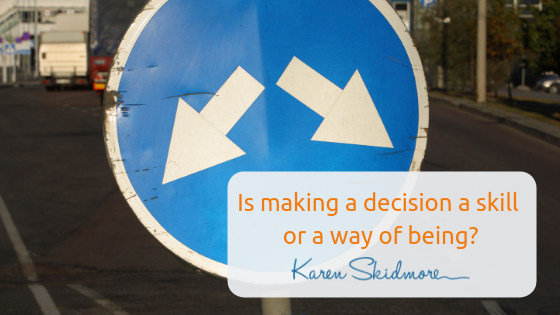
by Karen Skidmore | 02,19 | Marketing Articles, Pillar Articles
The number of choices you have to make to each and every day can add up into the thousands; from what clothes you put on in the morning and what you eat for lunch to what podcast you listen to next or radio station you play in the car. In fact, some sources claim that we make up to 35,000 decisions every day.
So it’s no surprise that, when it comes to making decisions about your business and marketing, that decision fatigue can become a real problem. If you’re already facing a thousand or more decisions about day-to-day stuff, when you apply the same decision making process to bigger business and marketing stuff, your brain can be running tired and wired.
It’s like having too many tabs open on your browser or too many apps running in the background of your phone … because your brain is full of mundane thinking, it just doesn’t have the capacity to move up a gear to deal with the seemingly bigger or more important decisions about your business.
I believe decision making to be one of the “secrets” to business success. It’s action, rather than ideas, that grow your business and action can only happen once you’ve made a decision.
So if you find it difficult to make decisions, it can really hold you back in your business growth journey.
 Many years ago I came up with The P Cycle; the constant and exhausting swirl of perpetual learning, which leads to perfectionism, which leads to procrastination which leads straight back to perpetual learning.
Many years ago I came up with The P Cycle; the constant and exhausting swirl of perpetual learning, which leads to perfectionism, which leads to procrastination which leads straight back to perpetual learning.
Because when you don’t know something (which is ALWAYS the case with most of your business and marketing decision, yes?!), it feels easier to go out and learn more about whatever it is you are making a decision about first, before actually making a decision to take action on it.
This means you are forever seeking ideas and learning more about how to do something … but you never quite get out of The P Cycle to take actual action and move forward with your business idea or marketing initiative.
So is decision making a skill you can learn?
Yes, sure it is. You can use tools such as the classic SWOT or cost-benefit analysis to help you weigh up the pros and cons.
But for most of your decisions you have to make to move forward with your business or marketing, I’ve found many of these decisions making tools have the danger of keeping you in the P Cycle.
Because you go off and learn how to make a decision, you try and get the decision making process right (AKA perfect!) which delays the decision making process even further and thus stops you from taking action.
Is there another way of making a decision?
Yes. I’m glad you asked 🙂
Because there is an important space within us that very few of us know how to access on a day-to-day basis.
You probably feel it from time to time and perhaps, like me, you know it’s there because so many people around you refer to it. Some people call it a gut feeling. Others may call it intuition. It doesn’t really matter whether you may feel it or hear it in your gut, soul, heart or solar plexus, it’s the thoughts and feelings that come to you when you may meet someone for the first time or walk into a room or in the middle of a conversation with someone.
Having spent the first 25+ years of my adult life as a strong, independent Super Woman (yup, I really was on track to burn out by the time I got to 43 – I just didn’t see it coming!), I really didn’t know how to access this intuitive way to help me make decisions. I was so busy making decisions based on logical thinking, that it was burning me out. Just like that browser with too many tabs open; at some point, you are painstakingly watching yet another spinning circle of doom that you realise the only thing you can do is re-boot the whole of your machine.
So a few years ago, I decided I need to re-boot, slow down and explore different ways of growing and building businesses.
 Let me hand you over to my good buddy, Kate Wolf, who is an expert on this matter.
Let me hand you over to my good buddy, Kate Wolf, who is an expert on this matter.
“Everyone is designed differently which means we all ‘hear’ our intuition in different ways. Some people hear words or phrases, for others, it’s a ‘feeling’ or sixth-sense. And for others, it’s an actual physical feeling or sensation in the body.
The key is to take the time to discover how your intuition speaks to you. The more you ‘listen’, the more you’ll ‘hear’. It’s also a journey of trust and courage. As you start honouring your intuition and daring to act on it, it will show up more for you and your relationship will strengthen.
Often people think they’re not intuitive but when I ask them to tell me a time they ‘just knew’ something was the wrong decision for them – whether it’s in the realm of business, finance, relationships, health or pretty much anything – everyone can come up with something.”
So if you’d like to find a way of accessing your intuition more to help you make decisions more easily – and thus take action on the stuff that’s going to grow your business – here’s what I love to invite you to do.
Learn to be a tracker of how your intuition shows up.
I’ve been on a huge journey over the last few years, re-connecting with myself and discovering how our energies work. I have had to learn how to slow down so that I may hear what my body and soul is trying to tell me.
A couple of the regular practices I use to allow myself to track how my own intuition comes up are are journalling – the simple practice of writing a few pages of my thoughts before I start my working day – and using Angel Cards – picking a card before or during my journaling to help me bring awareness to what I should be paying attention to. Both these practices allow me to get out of my head and feel into different parts of my body and awareness. And from here, I can pay attention to source rather than the exhausting logic.
There’s so much more I want to share about this topic but I want to finish off today with these final thoughts from Kate.
“It can be very easy to mistake projection for intuition. One of the key ways to recognise your intuition is that it comes without a story. If you find yourself explaining WHY something is so, and telling yourself lots of stories about it, it’s almost definitely some form of projection. Intuition simply is. It doesn’t need to explain itself, rationalise or justify.
So if your ‘sense’ or ‘feeling’ is coming with a lot of story and explanations, it may well NOT be intuition. When this happens, take some time to meditate, to journal, to get beneath the story to the truth. This is also a good time to turn to a skilled Coach or Healer who will guide you out of the story-mess of your head and into the wisdom of your body.”
I find I can use stories A LOT in my thinking when I’m running my decisions purely on logic, which is helpful when working with my clients because I can see them do exactly the same thing LOL. So this is great advice from Kate, particularly if these kind of practices are new to you.
If you have anything to add to this, please leave a comment below. I’d love to know how this article shows up for you and what you do to help you access your intuition.
Thank you for reading. Until next time, do less, be more, play bigger.

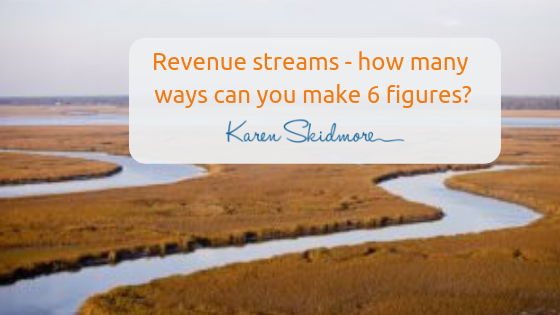
by Karen Skidmore | 01,19 | Marketing Articles, Pillar Articles
No, it’s not a trick question nor am I about to launch into some scammy way of turning on a money tap whilst lounging back on a Caribbean sundeck. It’s a serious question that all experts and service-based professionals need to answer at some point in their business.
Of course, the sum doesn’t have to be 6 figures. If you read my book, True Profit Business, you’ll discover that I am not a fan of pushing out the 6 figure business dream; it’s an ego-driven target because the reality is that most “6 figures” mean some an entirely different money-in-your-bank-account-sum when you take into account exactly what profit you made and what you sacrificed to get it.
Too many people are simply burning out to achieve the wrong goals.
If it is a genuine 6-figure sum you’re after, great, but the money sum could be that you simply want an extra £10,000 over the next few months. For the sake of simplicity, the money sum I’m going to use in this article is £100,000 because it’s as an easy number to work through.
First of all, why is this question important?
Knowing how you want to make your money from your business is important because it’s going to significantly impact your marketing strategy, positioning required, resources needed (advertising budget, hiring of team, cost of digital platform set up), skills to learn and how much time and effort you are required to get it all working.
Your business model – how you shape your revenue streams and how you engage with your clients and deliver your products – is directly related to how well you can grow your business. You may not have realised this before now, but you have a choice in the way your design, set up and run your business. Most people like yourself end up with a business model based on what everyone else in your profession is running or a business model based on what you’ve been taught to be the most profitable or easiest to run.
In the first instance, you may have the same business model as everyone else in your profession not because of choice, but because you don’t know any better. What you don’t know, you don’t know and, as with most clients I work, I doubt you’ve gone to business school or have training in business processes and systems.
If this is the case, you may have spent a lot of time learning about marketing and how to get clients but the topic of how to design, set up and run your business is something you’ve probably never given much thought to. Doing what everyone else in your profession does has its upsides because you know what works already. However, there is a big problem with this.
Just because most of your colleagues or competitors are running their business in a particular way, it doesn’t necessarily mean they are all doing it the right way for them. If we take the Pareto Principle that statistically proves 80% of your outcome comes from 20% of your input, 80% of the success that happens in your profession comes from just 20% of the businesses. Thus 80% of businesses in your profession is creating just 20% of the output.
Hmmmmmm. No wonder so many of your colleagues and competitors seem to be struggling when you get to see what’s really going on behind their marketing, promotional campaigns and brand presence.
You know if you are in the 80 percentile if you experience any of the following:
- You’re overwhelmed; you’re procrastinating over marketing initiatives and new product ideas because you simply don’t know what you “should” be doing to make your business work more effectively.
- You’re overworked; you are stuck in the day-to-day grind and feeling miserable that you can’t spend the time doing more of what you love
- You’re underpaid; you compete on price, charge by the hour or the time you spend with a client and often over-deliver so that you do far more than you originally promised thus dropping your value even further.
I know this paints a pretty depressing picture but there are plenty of you in this situation (you are part of the 80%!) and if you get a copy of my book, True Profit Business, you’ll discover the path out of this 80%.
What are the top 20% of your profession are doing to have a greater output?
There will be of course all sorts of reasons for their success but there is every chance that they are using technology to create huge growth advantage opportunities to allow them to stand out as a leading expert in your profession. You’ve probably already seen colleagues and competitors create new ways of sharing their expertise. From expanding their offerings to serving groups of clients, large and small, through to creating digital content and using cutting edge use of artificial intelligence; the opportunities to do something “different” and grow the number of clients you work with are open to you if that’s what you want.
This leads me to the second instance where many of you may be. The explosion in selling digital content since 2015 has led to thousands of marketing experts teaching digital ways of making money and growing a business from your laptop on the beach, particularly within the coaching, therapy and training professions. Because technology has been the reason for a lot of businesses’ success, it’s easy to get sucked into believing that digital is the only way to grow a business like yours. But that’s not simply the case.
Many marketplaces are now so flooded with digital offerings that it’s hard to break in and claim your space, especially when so much of the content can be of poor quality and your client base may have begun to distrust this form of learning or support. Plus there are plenty of those 20% businesses in your profession who are running more traditional business models, but because you don’t get to see their marketing campaigns or brand presence on your Facebook or Instagram feed, you may not realise they exist.
And let’s get real about how it is to run a top 20% business. You may have a business that, on paper, is well within your profession’s top 20%, especially if you are measuring its success on traditional key performance indicators such as turnover. But the reality of running your business in the top 20% is that it may be burning you out.
You know if you are getting burnt out in the 20% if you experience any of the following:
- You’re overwhelmed; you’ve stepped up and created your expert status but you don’t like the visibility and constant pressure to perform.
- You’re overworked; you can’t seem to keep up what you’ve promised your clients and can’t come up for air long enough to hire the right people to help you grow.
- You’re underpaid; your turnover maybe 6 or 7 figures but there’s not much left for you once you’ve paid your team, advertising invoices and running costs.
Again, another pretty depressing picture. But as before, you aren’t the only one to have created a business that is burning you out because this practice of growing a business based on following someone else’s formulas and business model is rife. This is why I want to open up your eyes and see the possibilities available to you on your path to creating a True Profit Business. My mission here is to help you to avoid following someone else’s proven business model and systems, just because they are telling you it works for them.
You have a choice.
You have a choice on what business infrastructure, processes and team to have in place to give you the right business to help you achieve your creativity, purpose and money aspirations. You can choose the design, set up and how you run your business based on who you are and how you want to show up, just the way you can decide on the right vehicle you want to drive day-to-day.
The reason why there are so many different types of vehicles on the road is that each and every one of us has a different reason for choosing our mode of transport, and at different stages of our lives. Starting out, you’ll drive any car you can afford; a small hatchback or perhaps stick to your bike, especially if you live in a city. Families may drive a big SUV. Some may like fast cars. Others choose their mode of transport based on environmental impact and may even decide they don’t want to own a vehicle but use uber or rental cars for longer journeys.
There’s no one vehicle that’s right for everyone or for a specific profession.
And so it is with your business model.
There are four critical decisions to make to help you decide which business model you want; your role in the business, the number of clients you want to serve and then consequently at what price point, how you deliver your service or products and which selling system you decide works best for you. In my book, True Profit Business, I am taking you through in detail all four of these decisions. So for now, let me take you through a couple of examples.
The passive income dream.
Someone I spoke to recently had recently spent a significant amount of her investment cash setting up a new membership website. She had read a lot about membership sites, had joined an online business mentoring programme to teach her the basics of setting up digital products and thought this would prove to be a perfect revenue stream to have around being a mum at home with two young children. She wouldn’t have to travel anywhere and she could do everything her business needed her to do from her kitchen table.
There was no questioning her passion for helping the audience she wanted to reach out; she knew they were desperate for clear signposting and easy to access advice. But 14 months in and her beautifully designed website was verging on a marketing disaster. Although visits to the site were climbing and she was good traction in the forums, database building was almost non-existent and her offer just wasn’t compelling enough.
Her plan was to start with the freemium model and then start charging £27 a month. She had dreams to have a 6-figure business but to make £100,000 that would mean 309 members, assuming that all 309 would stay a minimum of 12 months. That’s a whole lot of leads to get that many customers, and a whole lot of customer retention strategy to keep them being members.
Of course, long term this kind of membership model can work but you need a big bucket of resources (advertising, customer support, time, energy and hours and hours of screen time) because your marketing strategy is focused on high volume, low pricing model. It’s highly unlikely that any decent profit will be made for at least a year or two (probably many more!) if you are relying solely on this kind of revenue model. And this person was burnt out already after 14 months of struggling to build up her tribe on a bootstrap budget and a lack of skills around digital marketing and advertising.
Let’s go the other end of the scale.
A client I worked with recently came from many years in the publishing industry. Now I am sure you are aware of the massive changes that have turned much of the publishing sector on its head. The problem she was still stuck in the traditional, old school business model where very little revenue was created until a book was published and selling. For her business to make £100,000, it was all about book contracts; working hard upfront and only seeing rewards when (and sometimes only if) the book was successful. Plus it was a cost-heavy business so profits were tight.
When we starting diving into the process she went through with her author clients, it was apparent to me, almost immediately, the value of what she did even before the content was written. Of course, being surrounded with the traditional – and very much outdated – publishing business model, it was a classic case of “what you don’t know, you don’t know.” But having talked through all her options and what role, client capacity and delivery process would work for her, it was as if a searchlight was beaming through the fog and a new path became clear.
Offering her services as a book coach and mentor at the start of the process was an obvious place to begin; charging for the 6 months run-up to get the book ready for editing was not only profitable for my client but incredibly powerful and instrumental for the success of her author clients. Again, not a holy grail solution to making 6-figures – there was still a lot of thinking and doing to be done around her positioning and marketing her new offerings – but she could see clearly that this additional revenue stream could be a far simpler way of growing her business revenue than sticking to what everyone else in her industry did.
And without distracting her from her core revenue base or burning herself in the process.
The price you decide to charge has a lot to do with your success.
Before I send you off to have a think about your potential revenue streams, let’s deal with the elephant in the room; the price you charge. When creating new revenue streams in your business, it’s often perceived easier to start at the lower end of charge of the price scale. I’m sure you have seen, and perhaps even bought from, the classic product funnel that gets you started with a £10 introductory product, which leads into a £295 course and then takes you into a premium programme of £1,000 and more.
So what many do, and are taught to do, is start creating your £10 introductory offer because you believe you need to build your list. And a £10 product is so much easier and safer to create, is it not?
Coming back to the question on hand – how do you go about creating £100,000 … that’s a lot of £10 sales you need to make to build enough momentum to move people up to your next mid-level product. You’d probably be needing 500+ sales to get you the conversions to that £100,000. That’s exhausting (and I speak from experience!)
Again, like the membership offer example above, this kind of product funnel works. There’s no doubt about it. But starting with the perceived easier end of the funnel is not always your easiest path to growing your business. A far quicker, simpler and easier way can be to flip your funnel on its head and start at the top end of the scale. Even if you decided to start small and create a programme or service at around the £2,000 mark, it becomes obvious that you have to sell to far fewer people to get yourself to your £100,000 goal. Plus you’ll gain valuable experience, build your credibility and see better results from your clients working at this level.
Now, of course, I’m starting to sound like the rainbow fairy.
“Just wave your wand, burn your candles and the unicorn will come and poop out those clients for you.”
You know clients aren’t going to magically appear with intention alone (don’t you?!). There is focus needed for your overall strategy and positioning, a clear offer created and an understanding of what your market place really wants. But I hope that you get the point that I am making here and that you realise you have a choice about how you design, create and run your revenue streams in your business.
Think carefully about your pricing and offers as you grow your business.
Don’t just follow someone else’s system that they are selling you or stick to what your industry does best, because it’s not always the case. Start with where you want to go in your journey and what income and impact goals you want.
Thank you for reading. Until next time, do less, be more, play bigger.


by Karen Skidmore | 10,17 | Pillar Articles
How to stop to-do lists and post-it notes from ruining your business
To-do lists don’t work. You may think they do. But they don’t.
You may prefer to use post-it note reminders; cover your desk and screen with those pesky yellow tabs that always seem to fall off at precisely 74 minutes after you’ve stuck them. But these don’t work either.
There may be many ways that you are using to-do lists or post-it notes. Some people have one piece of paper that they start on a Monday and add to throughout the week. When you run out of space at the bottom, you write vertically down the side or add speech bubbles in any white space left. And then when you’ve run out space, you start to staple extra pages together that ends up as a tattered document that looks like a prop from a Pirates of the Caribbean film.
Others diligently start a new list each and every morning, transferring everything that hadn’t been crossed out from the day before, to a new piece of paper. There are often several items that have been transferred for weeks on end; you don’t remember when exactly those first appeared but they just keep being added to the fresh list, pretending they are just as important as all the other items on the list.
And then there are the online to-do listers. Wow … never has there been so much pleasure in having limitless space to categorise, colourise and prettify your to-do list. And don’t worry if any tasks go from green to amber to urgent red … there’s always the snooze button to click to send it down a few priorities.
No matter what kind of to-do lister you are, there’s every chance that you also spend a lot of your time blaming the fact that you have no time to get things done. You sniff out productivity tips and spend money on planners and goal setting diaries but at the end of every week, you still scratch your head and wonder where the past 5 days have gone.
Why is it that you feel stuck in the busy-ness of emails, client prep work, meetings, attending events, grocery shopping, getting the car serviced and walking the dog?
And that you never really find the time to do the stuff that is going to grow your business?
If you recognise yourself in any of these to-do listers, you are not alone. Whether your list making is an addiction, where you find yourself writing things down only so you can cross them off (come on … we’ve all done that, haven’t we?), or it’s simply the only way you know how to remember the things that need doing … you need to stop.
To-do lists are fine for those 3 or 4 admin things that have got to be done before 11 am but as a way of helping you be productive and get the projects done that are going to move your business forward, then they’ll ruin you.
Here’s why:
1. No dates – without a date for something to be done by, it has a habit of never being done. You will pick the things on the list that feel easier and leave the stuff that feels harder for another day. So without any done-by dates, your to-do list tasks are filtered by emotions rather than a sense of discipline or urgency.
2. No order of priority – I know you may kid yourself that your tasks are categorised but creating headings and subheadings is usually done because of procrastination and avoidance rather than any resemblance to a plan. Pretty pens and colour highlighters are signs that you may just don’t want to do (or know how to) what’s on your list.
2. Wrong stuff – the only time I believe a to-do list is to be used is for your daily tasks and admin stuff. The one piece of paper that you have on your desk that keeps you on track for that invoice you need to send or thank you note to a client. Most to-do lists have stuff like “Do Website” or “Sort out social media content plan”. These are NOT to-do list tasks … these are projects and need to be treated as such.
Without dates and prioritisation and focusing on the wrong stuff, you will find it incredibly difficult to grow and build your business. So if to-do lists and post-it notes don’t work, what’s the answer?
As boring and dull as it sounds it is good old-fashioned planning.
Now I get that most entrepreneurs and creatives hate planning. Your brains are often not naturally wired to put things into logical order or be able to timeline a project. But that doesn’t mean you can’t start exercising your planning muscles, because if you truly desire growth in your business and you want to get out of the rut of your business trundle, then start exercising you must.
A good plan simply means two things:
1. Start with the end in mind – decide on a date with said project (such as the new website or develop a new programme) needs to be completed by and from this you work backwards. This is I know hard because, in theory, there is no “need to” about it. You can quite happily trundle along for months and even years without your website finished or new programme sorted. This is why it’s critical that you, as the CEO of your business, makes a decision on a specific date.
And not a “by end of April” kind of date … I mean which day and date, and perhaps even time.
2. Milestones – Once you’ve fixed your date for whatever project you want to be completed, there will usually be 2 or 3 milestones along the way. With your website project, it could be along the lines of copy & site architecture created and the first draft. For your new programme plan and smaller projects, it could be mapping out the content and being clear on what you’re offering, then opening up invite list and having content ready for new clients. Don’t over complicate this process but you simply can’t avoid finding the space and the time to do this. It will only be hard because you’re in the to-do list mindset and you’re thinking in vertical lists. Exercise and stretch out your planning muscle and you’ll get better at thinking at horizontal timelines.
Every time one of my GID School students or Momentum members feels overwhelmed or frustrated by the lack of time they feel they have, taking the time out to plan out their business growth projects, put dates in their diaries and create a timeline of tasks, the sigh of relief is huge.
The weight of busy-ness is lifted off their shoulders and they actually realise how much time they do have to spare, compared to the frenetic chaos of running their businesses from to-do lists and post-it notes.
It’s why I run quarterly 90 Day Planning Mornings for my clients, to help give them not only the process and structure but also space and time to get it done.
If you would like to know about the topic of planning and get a practical lesson on how to turn your business vision into do-able and highly achievable 90 Day Plans, then check out my next Playing Your Bigger Game event happening on the 24th November. It’s one of the topics that I am focusing on during the day.
24th November at The Elvetham, Hampshire
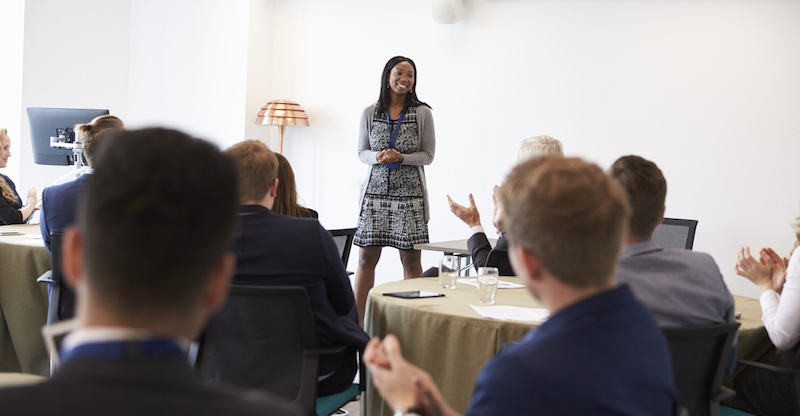
by Karen Skidmore | 09,17 | Marketing Articles, Pillar Articles
Marketing live events in this digital age?
I’ve gone back to marketing live in-person events again. After a three year run of being totally digital, I’ve realised how much I missed running them and how important they are to a business like mine; a business that needs me to show up and be visible.
Perhaps you’re the same? It’s your expertise or special ninja skills that your clients are buying.
Access to easy to use and cheaper tech tools have meant that more expert-led businesses have been able to switch to running events online. Webinars and teleseminars were only for the technically savvy 5 or 6 years ago. But now, platforms such as Facebook and Zoom have made it cheaper and easier than ever to run a virtual event, whether that’s a full presentation style webinar or regular live video broadcasts from your phone.
Going virtual has also made global collaboration easier than ever; there’s no need to jump on a plane, train or automobile to reach audiences on their own turf. I’ve never been part of that international speaking circuit where it may be a different city every night but I’ve heard enough of the stories to know travel isn’t as glamorous as you may see it on Instagram.
I used to run half-day workshops every eight weeks in my early years. Back in 2005 through to 2007, these training events where the backbone to my marketing strategy. I sold low priced tickets – between £50 to £75 – and filled each event with 15 to 20 people. And each event would give me three or more people upgrade to become private coaching clients.
Those Business Forum events were instrumental in creating a steady £40,000 annual revenue, whilst working part time, term time when my kids were in junior school.
But my Achilles Heel, boredom, kicked in and I wanted to do something new and different so started to go more online. It was those early days of digital marketing and my love of teleseminars led me to run webinars and taking my training online through group programmes and my membership club, Web Tech Club.
I carried on and ran the odd live event here and there. Web Tech Live one day events proved popular and I ran one programme, Profitable Products, as a mix of virtual training and live workshop.
But setting up, promoting and running live events got to be knackering for me because I was trying to do much of it by myself and often on a tight budget. The shiny shiny lights of digital marketing called to me and I got really seriously stuck into running online training sessions. From 2013 through to 2015, I spent a lot of time working on my webinar marketing system. And I got it working really well. It almost feels effortless to set up, promote and run a webinar now.
So why live events now … in this digital age?
Why go to all the effort, time and expense to run a live, in-person event when you can simply stay at home, in your slippers?
The truth is that this digital age isn’t quite what it’s cracked up to be anymore, compared to a year ago.
When we first started to see digital marketing opening up opportunities for our businesses four or five years ago, tech was fast to become accessible to everyone; you no longer had to a be tech person to get going. However, these past 18 months has seen this accessibility to digital marketing has meant big changes for businesses like mine and yours.
Whatever audience you are looking to attract, your marketplace probably feels very saturated now. It’s now very easy to create a gorgeous website, beautifully branded with incredible photography and have a marketing funnel that – on the outside – looks like it’s effortlessly bringing in leads and converting them to sales. Costs for business online set up have significantly dropped and it really doesn’t take much for a non-tech person to do a lot of themselves now.
However, that’s only part of the shit-mix that is being stirred up. Your biggest competitors are not any of these new pop-up businesses.
Your biggest competitors are time and attention.
Noise levels are now at an all-time high on each and every social media platform and don’t show any signs of quieting down. We are seeing trends that people are starting to request phones. Yup, phones that just call and text people; no apps, no internet access, no location tracking.
At the time of writing this, the new iPhone 8 and X are due out soon and there are signs that the marketplace is starting to say “How much?” Even the most avid iPhone user is showing that they may quite happy to stick with their 6 because they didn’t upgrade to their 7 and just can’t get their head around the fact that they could be spending more on a phone than they would their next holiday!
People are getting overwhelmed with how much information out there and are now – thank goodness! – becoming savvier in self-curating what they receive. From taking control of their Facebook newsfeed and blocking ads through to timers that lock down your app access during core hours.
Yes, I grant you, I don’t see this happening with my 17YO daughter yet LOL but there are more people now – your customers, perhaps? – beginning to realise that they can take control of the tidal wave of content that washes over them if they let themselves get sucked in.
Your content – blogs, emails, posts and photos – is now competing with millions of articles, videos, Facebook Lives and photos. So when it comes to marketing your next virtual event, it’s easy to see how your promotion just gets swallowed up in the sinkhole of online content.
And let’s not forget that that Facebook advertising, that may have been free-flowing leads for you a year ago, is now swamped with advertisers all wanting a piece of the gold land. It’s not surprising that your simple promoted ads a year ago, just don’t seem to get results this year. Facebook has their pick of their own customers now so keep in mind that your £100 budget may not worthy of their algorithm anymore.
So getting back to the topic of this article; why live events in this digital age?
There are lots of good reasons NOT to run live, in-person events. They aren’t necessarily any easier to promote because let’s get really clear … there are NO magic pills to swallow. Sorry, not sorry … let’s get real about your marketing right now.
So although I’d love you to take away that live events could be something for you to work on in your business, I also don’t want to sell this as the “easy option”.
1) Time
You need time to run a live event successfully. Not just in the promoting but also in the planning. So if you are in digital mindset, which means that you could decide to run a webinar in just 2 or 3 weeks time, remember your live event is going to need that in months … not weeks. If you haven’t run a live event before, I would recommend you need a minimum 3 months, ideally 4 or 5.
2) Money
Yes, you can do a live event on the cheap but I really wouldn’t recommend it. There’s no doubt you could book up your local community centre (or even a training room in a nail bar … that was the venue of my first event in 2004!!) but you have to consider your audience’s expectations and the value of the content you are delivering. There are all sorts of things that can suck money from you, from printed workbooks through to hiring an events coordinator to help you out on the day, so be prepared and get realistic about how much money you’ve got put aside before jumping in.
There are all sorts of things that can suck money from you, from printed workbooks through to hiring an events coordinator to help you out on the day, so be prepared and get realistic about how much money you’ve got put aside before jumping in.
3) Bigger vision
What is the reason you want to run a live event? Where are you leading your customers next? If your live event is the end point, you’re probably missing a huge opportunity. To see the true benefit of a live event, have the next step for your attendees to take after spending the day or weekend with you.
Whether you run an event as a low-priced event that you use to build trust and engagement to allow you to offer the bigger ticket programme or product on the day, or you sell a higher ticket price and run it as standalone event that flows into a longer-term solution, your event has far greater potential to grow your business being a lead-in for your core offer. Events can be a profitable revenue stream but think beyond them being your main tributary.
4) Support
You can’t run a live event by yourself. At a minimum, you need one virtual assistant or event administrator who can help with bookings and liaison with the venue. You need someone with an eye for detail who can organise and see what you’re missing (because you will … that’s always going to be the case!), whilst you do your “thing”. If you try to be the promoter, creator of content, workshop leader and organiser of refreshments, you will run yourself ragged and miss out on the potential of using your event to grow you and your business.
Have I put you off yet?
Now the great thing about this list is that is going to put a lot of people off running events. And that really is great news!
You see, running events aren’t the easy option so there are going to be a lot of people – your competitors, hopefully – who throw their hands up in the air as they see the work, time and effort needed and stick to the digital ways of doing things.
But digital is where all the noise is at.
Yes, I will be continuing to run my webinars for the foreseeable future. I love running them and they are easy for me to set up and promote right now. And I know how much value my subscribers and clients get from them. So this is not a case of “either or”.
But as I’ve shared here, we need to wake up and do things differently. We need to find ways of connecting with our customers and clients as humans, get out from behind our screens and let them see the whites of our eyes again.
Live events are NOT magic pills. And yes, you will be using digital marketing to promote them. But they sure are an incredible opportunity to stand out and be counted right now.
And that’s why I’m doing live events in this digital age.
Who’s with me?
Want to find out more about my next live event coming up this November?






 Many years ago I came up with The P Cycle; the constant and exhausting swirl of perpetual learning, which leads to perfectionism, which leads to procrastination which leads straight back to perpetual learning.
Many years ago I came up with The P Cycle; the constant and exhausting swirl of perpetual learning, which leads to perfectionism, which leads to procrastination which leads straight back to perpetual learning.  Let me hand you over to my good buddy, Kate Wolf, who is an expert on this matter.
Let me hand you over to my good buddy, Kate Wolf, who is an expert on this matter. 




